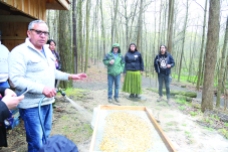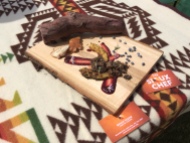The 2017 Great Lakes Intertribal Food Summit was held from April 19-23 at Gun Lake Pottawatomi’s Jijak Camp near Hopkins, Michigan. Over the five days, participants learned about both traditional foods and modern production practices through a range of workshops and hands-on learning and sharing opportunities.
The 2017 agenda expanded upon past events with additional emphasis on traditional tools and further integrating food preparation into the program.
The event began Wednesday morning with traditional technology workshops where participants could signup to make wild rice knockers, Haudenosaunee planting sticks, botagens (corn mortars), and woodland-style clay pots. Learning traditional methods helps provide a deeper understanding of traditional foods and how they were produced, harvested, and processed.
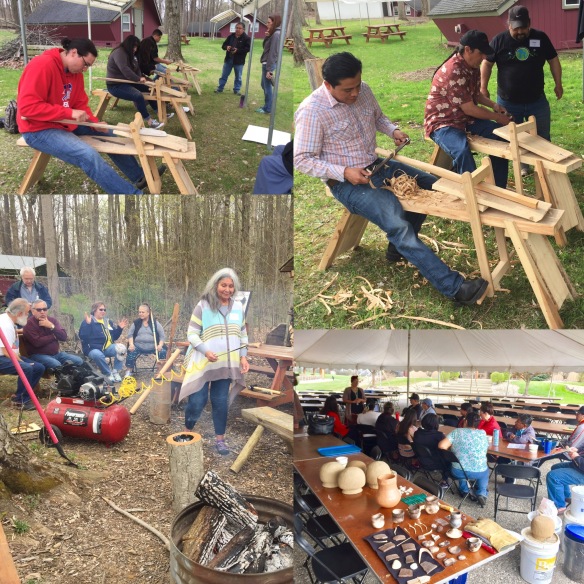
Wednesday afternoon featured in-depth workshops on conservation planning and safe food handling. The introduction to conservation planning provided background on the USDA Natural Resources Conservation Service (NRCS) approach to developing land management conservation plans that are required for accessing financial assistance for land improvement measures. The safe food handling workshop, led by staff from the Indian Health Service (IHS), covered the essentials of food safety, which is an important training for anyone providing food service…a major theme for this event.
Wednesday’s opening activities concluded with a bonfire that brought everyone together to wood-fire four clay pots that were then available for cooking throughout the event. Traditionally, these type of clay pots were vital cooking tools that could (and still can) be used directly in a fire. Of course the bonfire also provide a great opportunity for everyone to connect and discuss their experiences from the first day.
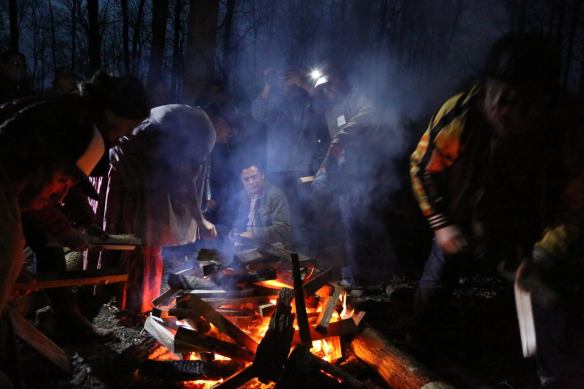
Photo credit – Dale Kakkak
The 2016 Great Lakes Intertribal Food Summit featured buffalo and churro lamb meat that was processed onsite in a butchering workshop. Challenges in sourcing a local buffalo and desire for an even more comprehensive butchering workshop evolved to bringing a live churro sheep that was ethically slaughtered by Aretta Begay from the Navaho Churro Sheep Association and a team of volunteers, including fellow Navajo, Brian Yazzie.
Indigenous foods like corn, potatoes, tomatoes, beans, cacao and squash are huge components of the modern global food system, yet many people have little awareness that each of foods originated in Turtle Island. This summit focused on those foods from both the production and culinary preparation perspectives.
Without seeds, there are no plants or the foods they provide. In today’s modern world, it is easy to go to the store and buy seeds to grow a garden or field, but our ancestors needed to save seeds in order to grow plants the following year, resulting in an amazing diversity of plant variety color, tastes, and suitability for localized growing conditions. Modern Indigenous leaders like Rowen White and Clayton Brascoupe are helping to reinvigorate these traditional ways through groups like the Indigenous Seed Keepers Network (ISKN) that is working to teach seed keeping and reconnect ancestral seeds from the communities where they originated. The summit featured four seed keeping workshops, plus a seed exchange where knowledge, inspiration, and seeds themselves were shared.
The summit also included numerous workshops on agricultural production, including soil health, forest management, conservation planning, season extension, grazing management, hands-on field preparation and planting, and cooperative development and value added production. While “experts” shared their knowledge on these range of topics, the workshops also provided a forum for participants to share what works best for them and discuss the challenges we all face in growing foods for both market and our communities and families. These workshops also placed an emphasis on hands-on learning where participants spent large portions of the workshops outside rather than simply in a classroom listening to a powerpoint presentation. These field sessions help to reinforce the learning and knowledge by increasing engagement.
Hosting the summit at a venue like Gun Lake Pottawomit’s Jijak Camp provided unique opportunities for harvesting and processing foods as part of the workshops and then using those foods as part of the meals served throughout the event. Wild ramps and onions, mushrooms, and an assortment of forest plants were gathered and sent directly to the kitchen. Other foods like hominy corn were processed and then included in meals. This type of educational approach reinforces the learning by immersing workshop participants in the process so they understand the full story of these foods and are then better able to bring the knowledge and inspiration back to their own communities.
All meals for this five-day summit were prepared onsite by a team of Native chefs using Indigenous ingredients. Rather than pay high prices required for conference center catering, this event put those funds into bringing about two dozen chefs out of the roughly forty chefs submitted applications to join this team. Feeding close to 300 people 3 meals/day is an enormous task, but this team did a tremendous job, incorporating education throughout the process.
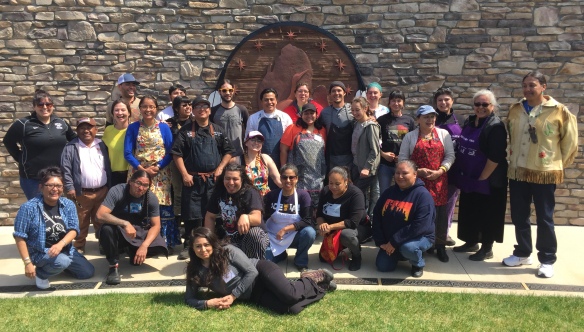
The Taste of the Tribes on Saturday afternoon was one of the highlights of the event, giving each chef or teams of 2-3 chefs the opportunity to create their own dishes, reflect the regional cuisines from their home regions while including a theme of Great Lakes ingredients.
Realizing that addressing the food and agricultural challenges faced by our Native Nations ultimately requires looking long-term by investing in and supporting our youth, this summit included a concurrent Great Lakes Region Youth Summit that brought together youth from not only across the region but a couple other regions as well. These youth participants spent time learning together as well as having the freedom to explore and participate in in the broader summit. Youth also had the opportunity to cook with the chefs and then serve food to the entire summit audience.
The Intertribal Agriculture Council and the rest of the planning team thanks the Gun Lake Tribe and each of the summit participants and sponsors for making the 2017 Great Lakes Intertribal Food Summit such a successful event. Discussions are underway for additional events in 2018 with a similar comprehensive approach.
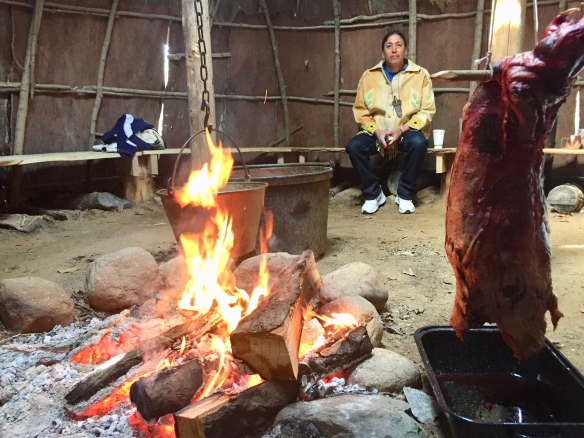
Checkout the Great Lakes Summit Brochure_2017 for more information, and search #foodsummit on social media for more pictures, posts, and stories.
Past Videos of Great Lakes Intertribal Food Summit Events:
Maizie White announces Jijak Luncheon
Maizie White describes the Jijak Luncheon at the 2017 Great Lakes Intertribal Food Summit at Jijak Camp near Hopkins, Michigan.
Foraging for Food, Fuel and Medicines: Hyssop
The Red Lake Ojibwe Nation and Intertribal Agriculture Council (IAC) take you on a short walk along part of the Red Lake Ojibwe Nation’s, Red Lake and the woods that surround it foraging for food, fuel and medicines as part of the Great Lakes Intertribal Fall Food Summit held at Red Lake, Minnesota during September of 2016.
Foraging for Food, Fuel and Medicines: American Basswood
Here is Kevin Finny, former Director of the Jijak Foundation for the Gun Lake Pottawatomi in Michigan speaking about the use of American Basswood, one of several species of trees identified during the fall 2016 Intertribal Food Summit held on the Red Lake Ojibwe Nation during September.
Foraging for Food, Fuel and Medicines: Milkweed
With Kevin Finney, former executive director of the Jijak Foundation and Tashia Hart of the Sioux Chef Team in the woods and fields of Red Lake Ojibwe Reservation foraging for food, fuel and medicines as part of the Great Lakes Intertribal Fall Food Summit during September of 2016.
Food Festival Chefs Special at Jijak 2016
During the 2016 Intertribal Food Summit the Saturday’s most favorite presentation were the Chefs special Food Festival — where each chef or team had a chance to prepare and serve to participants their special main dish, salad or dessert.
Making Traditional Ricing Sticks with Roger LaBine
Roger LaBine works with participants making wild rice knocking sticks at the 2017 Great Lakes Intertribal Summit.
Foraging and Harvesting from the Forest
One of the featured workshop of the Intertribal Food Summit is the Foraging for Food workshops. At the Red Lake Intertribal Food Summit it was called “Harvesting from the Forest” and was be led by Tashia Hart of Red Lake, who works with the Sioux Chef, Sean Sherman. Many other participants assistde in identifying and harvesting for the feasts, plants and medicines that are commonly used by Indigenous people for health and nutrition.
Buddy Raphael and the family Bootagan
Buddy Raphael discusses the family Bootagan that they use to grind rice, corn, barley and other products. The Bootagan, or grinding (smashing) cylinder is made of birch and Buddy worked with several participant to help them build their own. The next video below is also about making a Bootagan.
Making Anishinabe Corn and Flour Mortars
Participants at the 2017 Great Lakes Intertribal Summit are shown how to make and use a traditional corn, rice, barley mortar for pounding into meal.
Making Haudenosaunee Planting Sticks
Clayton Bascoupe assists participants at the 2017 Great Lakes Intertribal Food Summit making traditional Haudenosaunee Planting sticks.
Today’s Menu by Brian Yazzie – Jijak 2017
Touching base with just one of several Indigenous chefs in attendance at the 2017 Great Lakes Intertribal Food Summit at Gun Lake’s Camp Jijak.
Foraging at Jijak for Food and Salads – 2016
Participants of the 2016 Intertribal Food Summit at the Gun Lake Pottawatomi Tribe’s Camp Jijak forage for food and medicine for the event’s meals, while learning about plants and medicines from the woods.
























